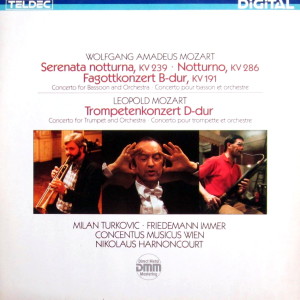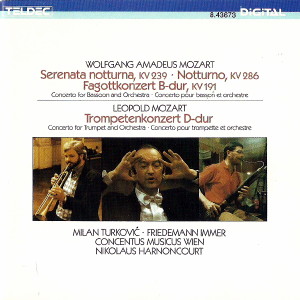 |
1 LP -
6.43673 AZ - (p) 1987
|

|
| 1 CD -
8.43673 ZK - (p) 1987 |
|
Wolfgang
Amadeus Mozart (1756-1791)
|
|
|
|
| Serenata notturna für
zwei kleine Orchester, KV 239 |
|
16' 03" |
|
| - Marcia: Maestoso |
4' 44" |
|
A1 |
| - Menuetto: Trio |
4' 50" |
|
A2 |
| - Rondeau: Allegretto |
6' 29" |
|
A3 |
| Konzert fur Fagott und
Orchester B-dur, KV 191 |
|
17' 58" |
|
| - Allegro |
6' 58" |
|
A4 |
| - Andante ma adagio |
6' 43" |
|
A5 |
| - Rondo: Tempo di Menuetto |
4' 17" |
|
A6 |
| - Choral "Hier ist das
rechte Osterlamm" |
1' 04" |
|
A7 |
Notturno für vier Orchester,
KV 286
|
|
18' 07" |
|
| - Andante |
8' 23" |
|
B1 |
| - Allegretto grazioso |
2' 35" |
|
B2 |
| - Menuetto - Trio |
7' 09" |
|
B3 |
|
|
|
|
| Leopold Mozart
(1719-1787) |
|
|
|
| Konzert für Trompete und
Orchester D-dur |
|
12' 01" |
|
| - Andante |
7' 27" |
|
B4 |
| - Allegro moderato |
4' 34" |
|
B5 |
|
|
|
|
| Milan
Turković, Fagott |
|
| Friedemann
Immer, Naturtrompete
in D |
|
|
|
| Concentus Musicus
Wien (mit
Originalinstrumenten) |
|
| Nikolaus
Harnoncourt, Leitung |
|
|
Luogo e data
di registrazione
|
| Teldec-Studio Zögernitz,
Vienna (Austria) - marzo/aprile 1987 |
|
Registrazione
live / studio
|
| studio |
Producer / Engineer
|
Wolfgang Mohr / Michael
Bramman
|
Prima Edizione
CD
|
Teldec - 8.43673 ZK - (1
cd) - 64' 50" - (p) 1987 - DDD
|
Prima
Edizione LP
|
Teldec - 6.43673 AZ - (1 lp) -
64' 50" - (p) 1987 - Digital
|
|
|
Notes
|
Sad to
say, we have lost
touch with the spirit
of the divertimento.
There is no comparison
between modern-day
“light music” and that
of Mozart’s time. And
concert-going has
become more and more a
serious experience
since the mid-19th
century. The modern
concert audience
listens to “sublime”
music with solemn
countenance , eyes
closed for better
concentration.
That was all quite
different in the l8th
century. The most
important thing was to
entertain a social
gathering, to amuse
even - on the highest
level, and with the
best musicians. Music
was written for an
educated elite, for
a particular occasion
and with surprise
effects - 18th century
audiences did not
listen as attentively
as modern
concert-goers, often
only taking notice of
the composition when
unusual phrases or
ideas “caught their
ears". Or the composer
wrote music of a
pureley “social”
nature such as
“Tafelmusik”
(banquetting-music) -
an aural background
for social occasions.
In 1776 Mozart wrote
an extensive series of
serenades. One of the
finest
of these is the "Serenata
notturna", K.
239. In Mozart’s day
music was usually
heard in the evening -
a contemporary
observed that there
was hardly an evening
“when we didn’t hear
some kind of
Nachtmusik beneath our
windows”. It is open
to doubt whether a
larger ensemble, in
this case even
including drums,
actually appeared
before people’s
windows. Likewise, the
adress for which
Mozart could have
intended this serenade
is unknown. Most of
his “occasional”
compositions (the name
is deceptive, for the
genre includes some of
his finest works) were
written to the
commission of an
aristocrat or other
patron who wanted to
enhance his soirée
with a new - and, if
possible, surprising -
piece of music.
The fact that the
Serenata notturna was
written and performed
in January suggests
that it was played
indoors rather than
outside the windows,
And the rooms used for
the festivities must
have been of a
reasonable size, since
Mozart called for a
string orchestra and a
quartet of solo
strings (in which a
double-bass formed a
spicy substitute for
the cello), to be
placed opposite one
another like partners
in a dialogue, The old
concerto grosso
principle of the
Baroque was thus
revived with a very
Mozartian sound - not
least because the
string orchestra was
backed by timpani.
Mozart may have
intended the two
groups of musicians to
play in two different
rooms.
Mozart restricted
himself to just three
movements here, and
these live from
contrasts. The opening
is a festive march
which makes varied use
of the two separate
groups of instruments.
This divided sound
seems to have been a
special source of
inspiration for Mozart
- he created one new
combination of sounds
and timbres after
another. In
the minuet he wrote a
trio that develops
delightful melodies
with the quartet sound
of the strings, as if
he had his beloved
woodwind before him.
There are few trios
with such cantabile
lyricism, even in
Mozart. The finale
sparkles with witty
use of contrast too -
an adagio passage only
ten bars long is
inserted to this end,
irony plays a decisive
role, as is possible
only in Mozart. He may
even have been quoting
tunes popular at the
time.
Just a year later,
Mozart wrote another “notturno”divertimento
for four different
groups of instruments
(strings and two horns
each), in which he
concentrated in
particular on the echo
effects that could be
produced. We do not
know whether Mozart
stopped working on the
piece because he had
to resort to the echo
effects too often - it
is not without
significance that he
ended with a minuet.
The different themes
were heard abbreviated
in the echo in each
case, with a result
that was both witty
and musically
consistent.
On 4th June l774
Mozart composed the Bassoon
Concerto in B flat
majon K. 191 -
his first concerto for
a wind instrument. The
concerto is not
dominated by the solo
bassoon in virtuoso
display - a kind of
dialogue develops
between the bassoon
and the orchestra. The
influence of Johann
Christian Bach and the
Mannheim school
composer Johann
Schobert is
unmistakable.
The soloist in this
recording, Milan
Turković,
writes of his
experience with the
concerto:
“This was my third
recording of Mozart’s
Bassoon Concerto K.
l9l. Notwithstanding
this prior experience
and the experience of
dozens of`concert
performances, the
making of the present
recording was a
fascinating adventure
both musically and
instrumentally - and
one without real
precedent in this part
of the repertoire. The
seven-key original
bassoon from the
workshop of`Kaspar
Tauber (Vienna ca.
l780), which is so
ideally close in date
to what is surely the
most demanding work in
the bassoon
repertoire, had
already given an
excellent account of
itself in works like
the Requiem and the C
minor Mass as well as
the Mozart Horn
Concerti.
The months of
intensive partnership
with this instrument
brought me many
insights of both
technical and musical
nature. It
became clear, for
example, that Mozart’s
Bassoon Concerto,
which can easily sound
charming and
unsophisticated when
played on modern
instruments, must in
fact have seemed a
bold composition to
contemporary
bassoonists, and must
have been interpreted
accordingly. The
exploitation of the
entire range of notes
available at the time
is clear proof of
this. We also noticed
during the rehearsals,
in concert in the
large hall of the
Vienna Musikverein and
during the two
recording sessions
with the Tauber
bassoon that the
extended cadenzas
customary today
(especially in the
second movement) seem
out of place in a work
of this kind.”
Leopold Mozart went
down in history as the
father of his famous
son. Wolfgang Amadeus
was his “oeuvre”.
Leopold Mozart’s own
compositions, however,
are for the most part
unknown today, with
the exception of the
Toy Symphony, the
Musical Sleighride and
the Concerto in D
major for Trumpet.
The Concerto was
written in 1762
and has become
increasingly popular
with trumpet
virtuosos. Friedemann
Immer,
the trumpet soloist in
this recording, has
written about the
difference between a
modern trumpet and the
Baroque instrument
played here:
“The Baroque trumpet,
also called natural
trumpet, is a
valveless instrument
similar to the
fanfare, on which only
the notes dictated by
nature, the so-called
“natural-notes”, can
be played. As we can
see from the natural
scale illustrated, the
natural notes are so
close together that
melodies are playable
only in the upper
register. This is also
the reason why Baroque
trumpet music is
written with such high
notes. In the low
register there are
only a few notes
available, here the
Baroque trumpet can
only produce triads.
Some of these
notes, as the arrows
show, are too high or
too low. My Baroque
trumpet, which is a
copy of an old
instrument, is fitted
with three small
keyholes, which help
to bring the
intonation of these
“unclean” notes closer
to what are used to
hearing. The
ditlerence from the
modern trumpet is that
the piccolo trumpet,
on which most Baroque
trumpet music is
performed nowadays,
has a tube length of
some 60 cm,
while the Baroque
trumpet is about 250
cm long - hence the
difference in sound. A
further point is that
the modern trumpet is
equipped with valves,
so that the sound is
produced by a
combination of lip and
fingering technique.
On the Baroque
trumpet, on the other
hand, two different
notes are produced by
differing lip tension
alone, which makes
trills for instance
very hard to play. The
art of clarion playing
- trumpet playing in
the high register -
had practically been
forgotten in almost
all of Europe in the
second half of the
18th century. Only in
Austria were there
still trumpeters with
a command of the art,
and it was here that
the most demanding
works for the Baroque
trumpet were composed
after 1750.
Composers like Michael
Haydn and Franz Xaver
Richter, as well as
Leopold Mozart, wrote
concerti for the very
high Baroque trumpet.
The low register,
which had been
included in earlier
compositions, was
neglected.”
Translation
Clive R. Williams
|
|
Nikolaus
Harnoncourt (1929-2016)
|

|

|
|